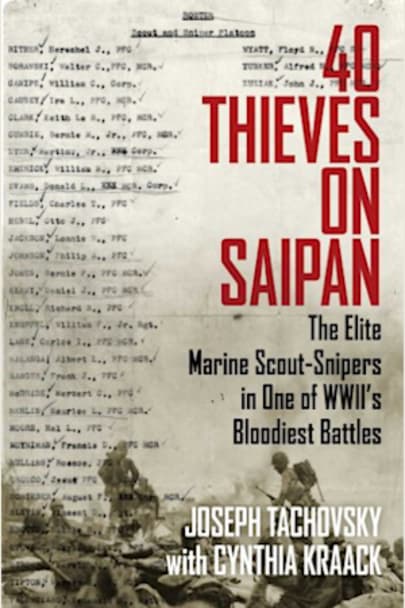Winner of The 2020 Best Book Award for Military History — American Bookfest An elite platoon of Marine Scout-Snipers, Lieutenant Frank Tachovsky’s “40 Thieves” were chosen for their willingness to defy rules and beat all-comers. When two Marines got into a fight, the loser ended up in the infirmary, the winner in the brig. Tachovsky wanted the winner on his team–a brush with military law was a … military law was a recommendation.
These full-blooded men were trained in a ruthless array of hand-to-hand killing techniques and then thrown into the battle for Saipan–Emperor Hirohito’s “Treasure” and the bulwark of the Japanese Empire in the Pacific–where they would wreak havoc in and around, but mostly behind, enemy lines. They witnessed inhuman atrocities; walked into an ambush after the cunning Japanese used wounded Marines as bait; endured body-punishing extremes of heat, hunger, and thirst; fought a relentless enemy who would not surrender; and watched best friends die.
Now Tachovsky’s son Joseph tells their remarkable story–a story he didn’t even know until after his father’s death–reported from an extensive documentary record, including priceless mementos his father kept, and from exhaustive interviews with survivors who served under Lieutenant “Ski.”
This is how America won the war in the Pacific, where “uncommon valor was a common virtue.” 40 Thieves on Saipan: The Elite Marine Scout-Snipers in One of World War II’s Bloodiest Battles is true history. It’s also an adventure you don’t want to miss.
more



The scenes and descriptions are vivid enough to make your heart race; the emotions and courage are palpable in the men and women at the center of 40 Thieves on Saipan. And this is especially true after you have lived among them, endured their selection and training regimens and sensed their apprehension, fatalism and bravery as their days as “thieves” on Saipan draw near. This is a book drawn from a stark, embattled history with the story arc and dramatic turns of a fictional tale of enormous import. This is the story of the origins, travails and adventures of Marines specially chosen to engage an enemy on its own ground and wreak havoc in any way they can so that US troops can gain and hold ground a few feet at a time on an island known to the Japanese as “the Emperor’s Treasure.”
Authors Joseph Tachovsky (son of Marine Lt. Frank Tachovsky, commander of the 40 Thieves unit) and Cynthia Kraack (Award-winning author of seven previous works of fiction) must have undertaken this literary effort faced with the daunting task knowing that not everyone critical to the story would want to talk about it. Knowing that some pieces were missing or compromised by time; realizing that piecing the stories into a readable text, both apocryphal and true, would be a formidable task. But penning the story of this group of young men whose efforts would provide the basis for United States’ victory over Japan in World War II, was so significant and powerful it demanded telling. So 40 Thieves on Saipan is history; it is also personal and vivid stories of young men who knew at the outset they might be doomed by their mission. And they went anyway.
40 Thieves begins on the enforested, humid and mosquito-swarmed island of Saipan, where a tired Marine realizes too late that his team is surrounded by an enemy whose uncanny ability to lie in wait patiently was almost impossible to imagine. After this tense and heart-pounding opening, you are taken back to the origins of the elite Marine Scout-Sniper unit; where a rigorous recruitment and training process offered rogues, rule-breakers and ruffian types an opportunity to flourish in the Marine ethos. Readers endure the arduous physical preparation the 40 Thieves used to ready themselves for a secret and dangerous mission. They are privy to the doubts, machismo and emotions of men whose lives were about to be changed forever or lost on a spit of rock in the Pacific Ocean. The story is accompanied by original source documents and photos of the 40 Thieves, along with letters and stories from the men and from their loved ones back home. One of the most intriguing things about this time was that while these Marines were engaged in intense battles as a team fully committed to each other and their mission, their wives, girlfriends and families back home formed a similar bond, supporting and caring for each other against the ache of loneliness and potential loss. Their letters back and forth are revealing while also being guarded against revealing too much.
40 Thieves on Saipan is indeed a story of the bloodiest of battles in the War in the Pacific. It is also a look at this time in history and at this unique idea of how to wage a war against an enemy often unseen and infinitely committed to holding ground by scorched earth destruction regardless of the cost in human life. The engagements, skirmishes and adventures of the 40 Thieves are detailed with careful detail, with the knowing sense that the men in this unique unit were both apprehensive, yet eager to engage, destroy and defeat the enemy far from home.
This story ends as war-hardened Marines witness in horror mass suicides and mass murder by the enemy of its’ allies and the indigenous peoples of Saipan rather than surrender, even as the Marines ultimately conquer the island from Japan. And you understand why most of the 40 Thieves that survived spent the rest of their lives trying to forget or drown these images, committed to never reliving their nightmares. The research, the grudging conversations and the difficulty of dredging through a history this personal is hard to imagine. Making it so interesting, so intensely accurate and unflinching in its revelations is even more remarkable. Histories this specific are where we learn the true impacts and harsh realities of war. Tachovsky and Kraack have earned the accolades they will receive from readers of 40 Thieves on Saipan.